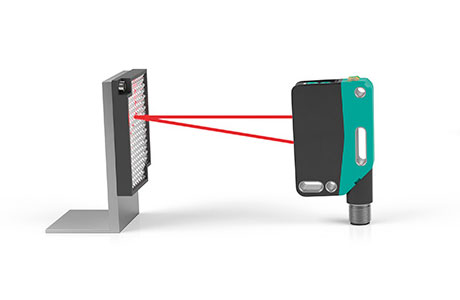Key Takeaway
Retroreflective sensors are versatile, reliable, and can detect objects regardless of material, shape, or color. They use a prismatic reflector, making them ideal for long-range applications. This ensures accuracy in detecting a wide variety of objects in industrial settings.
However, installation requires careful alignment, which can increase setup time. These sensors may also struggle with highly reflective or transparent objects, requiring regular maintenance to keep the reflector clean. Despite this, they remain a trusted choice in many industries.
Key Advantages of Retroreflective Sensors in Industrial Applications
Retroreflective sensors offer significant advantages, especially in complex industrial environments. One of their key benefits is the ease of installation. Unlike through-beam sensors that require a separate receiver, retroreflective sensors use a reflector, simplifying setup and reducing costs.
Another advantage is their ability to detect a wide variety of objects. Whether it’s shiny, transparent, or opaque materials, these sensors can efficiently identify them due to their reflective technology. This versatility makes them highly suitable for manufacturing environments where diverse materials are used.
Moreover, retroreflective sensors offer long-range detection, often up to several meters, making them ideal for large-scale applications such as conveyor systems.

Disadvantages and Limitations of Retroreflective Sensors
Despite their advantages, retroreflective sensors are not without limitations. One common issue is sensitivity to environmental factors such as bright ambient light or extreme temperature variations. In environments with intense sunlight or heat, their performance can degrade, leading to false detections or missed objects.
These sensors are also prone to reflection errors. For example, shiny or highly reflective surfaces can cause unwanted reflections, making it difficult for the sensor to distinguish between the actual object and stray light. This limitation is particularly problematic when dealing with mirrored or polished materials, requiring additional adjustments or special reflectors.
Another downside is their dependence on the cleanliness of the reflector. Dust, grease, or scratches on the reflector can impair sensor accuracy. Regular maintenance is necessary to ensure optimal performance, adding an additional layer of effort for the maintenance team. While they offer many benefits, understanding and mitigating these limitations is essential to maximize their usefulness.
How to Maximize the Benefits of Retroreflective Sensors
Maximizing the benefits of retroreflective sensors begins with proper setup. Ensure the reflector is mounted securely and is kept clean. Routine cleaning of the reflector and sensor lens can go a long way in maintaining accuracy. Additionally, placing the sensor at an angle that avoids direct exposure to strong light sources can help reduce the risk of false detections.
Another effective strategy is to choose the correct reflector based on your application. For environments with highly reflective objects, anti-reflection coatings on reflectors can minimize errors. Sensors with built-in filters or adjustable sensitivity can also help you fine-tune performance, particularly in harsh industrial environments.
Lastly, selecting sensors with higher immunity to ambient light and temperature fluctuations can make them more reliable. By choosing models with these features, you can minimize the risk of external factors affecting sensor operation. This approach ensures you’re getting the most out of your retroreflective sensors, enhancing their effectiveness in your operations.
Applications Where Retroreflective Sensors Excel
Retroreflective sensors excel in various industrial applications where long-range object detection is essential. One notable example is packaging lines. These sensors are often used to detect boxes, bags, or other items moving along conveyor belts. Their ability to detect transparent or reflective objects makes them ideal for industries like food and beverage, pharmaceuticals, and automotive manufacturing.
They are also widely used in material handling systems. In warehouses or distribution centers, retroreflective sensors help manage automated storage and retrieval systems by detecting pallets, bins, or other storage units. Their reliability in these large-scale operations helps ensure efficiency and accuracy.
In addition, retroreflective sensors are useful in security applications. They can be employed in perimeter monitoring systems to detect unauthorized access or in vehicle detection systems for parking and traffic management. Their versatility across these varied applications underlines their importance in modern industrial environments.
Alternatives to Retroreflective Sensors for Specific Uses
While retroreflective sensors are highly effective, they may not always be the best fit for every scenario. For situations requiring even more precise detection, through-beam sensors might be a better option. Through-beam sensors offer greater accuracy and are less susceptible to interference from reflective surfaces. They are ideal for detecting small objects at long distances or in environments with high ambient light.
For applications involving challenging surfaces, such as mirrored or irregularly shaped objects, diffuse sensors can offer a more reliable solution. These sensors operate by detecting light reflected directly from the object itself, eliminating the need for a separate reflector.
Lastly, in environments with high levels of dust, dirt, or moisture, ultrasonic sensors may provide better performance. These sensors use sound waves rather than light, making them unaffected by dust or debris. While retroreflective sensors are versatile, understanding the alternatives helps ensure you choose the right solution for your specific industrial needs.
Conclusion
Retroreflective sensors are a versatile and reliable option for many industrial applications, offering benefits like easy installation, long-range detection, and the ability to handle diverse materials. However, they also come with limitations, including sensitivity to environmental factors and reflective surfaces. To maximize their performance, careful installation, regular maintenance, and selecting the right sensor for the job are crucial. For some applications, alternatives like through-beam or ultrasonic sensors may provide better results.
By understanding both the advantages and drawbacks, you can make informed decisions about whether retroreflective sensors are the right fit for your industrial setup. Ultimately, it’s about balancing the pros and cons and choosing the most effective solution for your specific needs.
